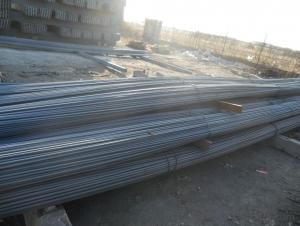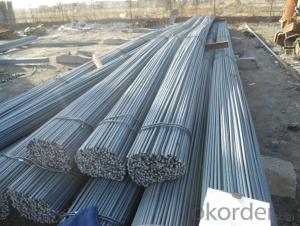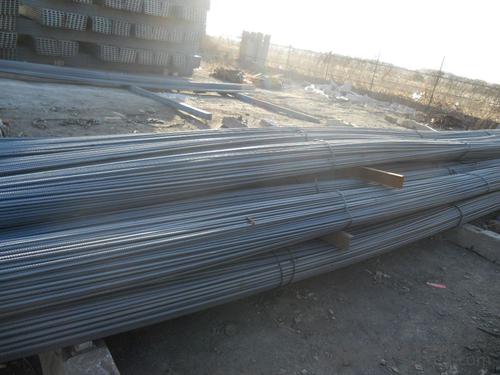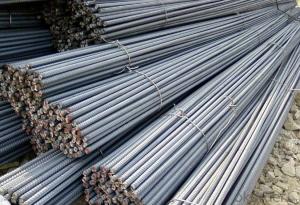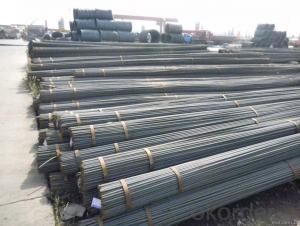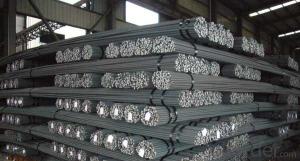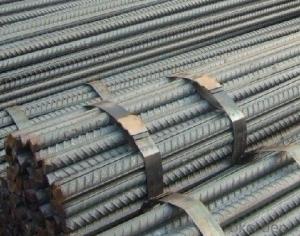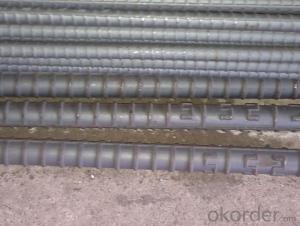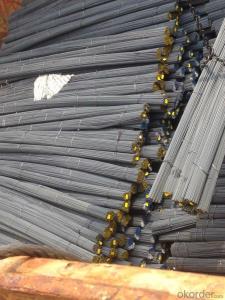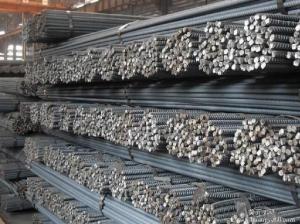Deformed steel bars type,Class IV Deformed Steel Bar with high quality
- Loading Port:
- Tianjin
- Payment Terms:
- TT or LC
- Min Order Qty:
- 50 m.t
- Supply Capability:
- 20000 m.t/month
OKorder Service Pledge
OKorder Financial Service
You Might Also Like
Product Description:
OKorder is offering Deformed steel bars type,Class IV Deformed Steel Bar with high quality at great prices with worldwide shipping. Our supplier is a world-class manufacturer of steel, with our products utilized the world over. OKorder annually supplies products to European, North American and Asian markets. We provide quotations within 24 hours of receiving an inquiry and guarantee competitive prices. We supplies a comprehensive range of standard N grade, 500 MPa deformed reinforcing bar (D500N). Length is available as your request as the reinforcing bar is often supplied processed or fabricated to suit the specific requirements of the project.
Product Applications:
Deformed steel bars type,Class IV Deformed Steel Bar with high quality are ideal for structural applications and are widely used in the construction of buildings and bridges, and the manufacturing, petrochemical, and transportation industries.
Product Advantages:
OKorder's Deformed steel bars type,Class IV Deformed Steel Bar with high quality are durable, strong, and resist corrosion.
Main Product Features:
· Premium quality
· Prompt delivery & seaworthy packing (30 days after receiving deposit)
· Corrosion resistance
· Can be recycled and reused
· Mill test certification
· Professional Service
· Competitive pricing
Product Specifications:
Manufacture: Hot rolled
Ref No. | Std Unit | Bar size mm | Length mm | Calculated metre per tonne(approx.) |
N10 | pcs | 10 | 6000 | 1582 |
N12 | pcs | 12 | 6000 | 1099 |
N16 | pcs | 16 | 6000 | 617 |
N20 | pcs | 20 | 6000 | 395 |
N24 | pcs | 24 | 6000 | 275 |
N28 | pcs | 28 | 6000 | 202 |
N32 | pcs | 32 | 6000 | 155 |
N36 | pcs | 36 | 6000 | 122 |
1 Size: From 6mm to 40mm
2 Length: 6meter, 9meter and 12meter
Package:
1: Bundle by steel strip
2: In bulk
3: Anti-water plastic woven
4: As your requirement
FAQ:
Q1: Why buy Materials & Equipment from OKorder.com?
A1: All products offered byOKorder.com are carefully selected from China's most reliable manufacturing enterprises. Through its ISO certifications, OKorder.com adheres to the highest standards and a commitment to supply chain safety and customer satisfaction.
Q2: What makes stainless steel stainless?
A2: Stainless steel must contain at least 10.5 % chromium. It is this element that reacts with the oxygen in the air to form a complex chrome-oxide surface layer that is invisible but strong enough to prevent further oxygen from "staining" (rusting) the surface. Higher levels of chromium and the addition of other alloying elements such as nickel and molybdenum enhance this surface layer and improve the corrosion resistance of the stainless material.
Q3: Can stainless steel rust?
A3: Stainless does not "rust" as you think of regular steel rusting with a red oxide on the surface that flakes off. If you see red rust it is probably due to some iron particles that have contaminated the surface of the stainless steel and it is these iron particles that are rusting. Look at the source of the rusting and see if you can remove it from the surface.
Images:
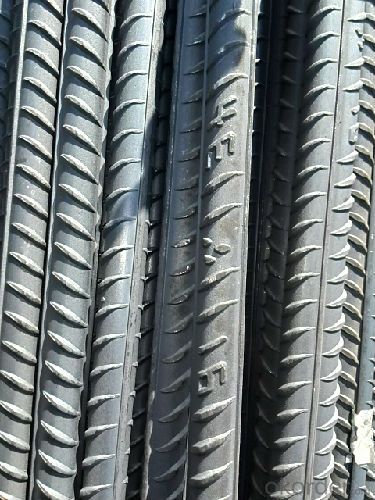
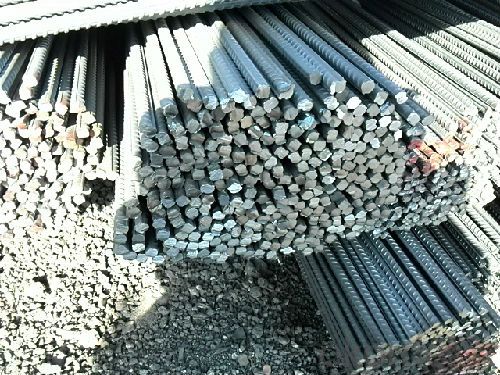
- Q: Can steel rebars be used in wind turbine tower construction?
- Yes, steel rebars can be used in wind turbine tower construction. Steel rebars are commonly used in the construction industry as reinforcement in concrete structures. In the case of wind turbine towers, the foundation and tower structure are usually made of reinforced concrete. Steel rebars help to increase the strength and durability of the concrete, making it capable of withstanding the loads and forces exerted by the wind turbine. The rebars provide reinforcement to the concrete and help in distributing the loads evenly throughout the tower structure, ensuring its stability and structural integrity. Therefore, steel rebars play a critical role in wind turbine tower construction and are commonly used in this application.
- Q: Can steel rebars be used in the construction of office buildings?
- Yes, steel rebars can be used in the construction of office buildings. Steel rebars are commonly used as reinforcement in concrete structures, including office buildings, to provide strength and stability. They are crucial in reinforcing the concrete and enhancing the building's overall structural integrity.
- Q: What is the effect of steel rebars on the durability of concrete structures?
- The durability of concrete structures is greatly influenced by the presence of steel rebars. When used as reinforcement within the concrete, rebars bolster the strength and longevity of the structure. While concrete itself is strong when compressed, it lacks tensile strength. However, by incorporating steel rebars, which possess high tensile strength, into the concrete, the overall structural integrity is significantly improved. The inclusion of rebars in concrete serves to mitigate the potential for cracking and structural failure. When exposed to external forces or natural phenomena such as earthquakes or temperature fluctuations, the rebars distribute the load and aid in resisting bending, shearing, and tension forces. This effectively prevents the occurrence of cracks and ensures the concrete structure remains whole and stable. Furthermore, steel rebars also provide protection against corrosion for the concrete. Concrete is susceptible to moisture and chemicals that can penetrate its surface and lead to the corrosion of embedded reinforcement. However, rebars act as a barrier, safeguarding the concrete from moisture and harmful substances that could cause corrosion. This extends the lifespan of the structure and reduces the need for maintenance and repairs. In conclusion, the addition of steel rebars in concrete structures greatly enhances their durability. They offer increased strength, resistance to external forces, and protection against corrosion. When combined, concrete and steel rebars create a robust and long-lasting structure capable of withstanding various environmental and structural challenges.
- Q: What is the impact strength of steel rebars?
- Steel rebars' impact strength can vary based on factors like steel composition, manufacturing process, and rebar grade. However, steel rebars are generally renowned for their high impact strength, enabling them to endure significant forces and impacts without fracturing or breaking. In construction projects, steel rebars are frequently employed to reinforce concrete structures and provide added strength. Their exceptional impact strength enables them to withstand heavy loads, vibrations, and even extreme weather conditions. The impact strength of steel rebars is vital in guaranteeing the structural integrity and safety of buildings and infrastructure. They play a pivotal role in preventing building collapse under stress, for instance, during earthquakes or when subjected to heavy loads. Furthermore, steel rebars can absorb and distribute impact energy throughout the structure, minimizing the likelihood of localized damage. In summary, the impact strength of steel rebars is a crucial factor in determining their suitability for various construction applications. Engineers and architects carefully evaluate this property when selecting the appropriate grade and size of steel rebars to ensure the durability and safety of their designed structures.
- Q: Can steel rebars be used in energy-efficient buildings?
- Yes, steel rebars can be used in energy-efficient buildings. Steel rebars are commonly used in the construction of reinforced concrete structures, including energy-efficient buildings. Energy-efficient buildings focus on reducing energy consumption and minimizing environmental impact. While steel is a material with high embodied energy, meaning it requires a significant amount of energy for its production, it offers several advantages for energy-efficient buildings. Firstly, steel rebars provide structural strength to reinforced concrete, allowing for the construction of durable and long-lasting buildings. This is crucial for energy-efficient buildings as they are designed to have a longer lifespan and lower maintenance requirements, reducing the overall environmental impact. Additionally, steel rebars can be used in the construction of energy-efficient building components such as insulated concrete forms (ICFs) and precast concrete panels. These building systems offer excellent thermal insulation properties, reducing heat transfer and improving energy efficiency. Steel rebars are used to reinforce these components, ensuring their structural integrity. Furthermore, the thermal mass properties of concrete, reinforced by steel rebars, can contribute to the energy efficiency of a building. Concrete absorbs and stores heat, helping to regulate indoor temperatures and reduce the need for excessive heating or cooling. This can result in significant energy savings over the lifespan of a building. It is important to note that the energy efficiency of a building depends on various factors, including insulation, window design, HVAC systems, and renewable energy integration. While steel rebars are an integral part of reinforced concrete structures, their impact on the overall energy efficiency should be considered in conjunction with other design choices and building materials.
- Q: What is the difference between steel rebars and FRP rebars?
- Construction projects use steel rebars and FRP rebars as reinforcement materials, but they differ in composition and mechanical properties. Steel rebars, made of carbon steel, are known for their strength and durability, making them a reliable choice for reinforcing concrete structures. On the other hand, FRP rebars are composed of fibers embedded in a polymer matrix, such as glass or carbon. This composite material offers advantages over steel rebars. Firstly, FRP rebars are lighter, making them easier to handle and transport, reducing labor and equipment costs. Secondly, FRP rebars do not corrode, unlike steel rebars. Steel rebars are prone to corrosion when exposed to moisture and chemicals, weakening the structure over time. FRP rebars, however, are resistant to rust and corrosion, making them ideal for environments with high humidity, saltwater, or chemical exposure. Additionally, FRP rebars have a high resistance to electromagnetic fields, making them suitable for sensitive areas like hospitals, power plants, or telecommunication facilities, where minimizing electromagnetic interference is crucial. However, FRP rebars have lower tensile strength compared to steel rebars, making them less suitable for heavy-load-bearing structures. Moreover, FRP rebars initially cost more than steel rebars, but their long-term durability and reduced maintenance requirements can offset this expense. In conclusion, the differences between steel rebars and FRP rebars lie in their composition, mechanical properties, and performance in various environmental conditions. Steel rebars offer high tensile strength but are susceptible to corrosion, while FRP rebars are lighter, non-corrosive, and have a high resistance to electromagnetic fields. The choice between the two depends on project requirements, load-bearing needs, and environmental factors.
- Q: How do steel rebars contribute to the strength of concrete structures?
- Steel rebars contribute to the strength of concrete structures by providing reinforcement and increasing their durability. When embedded within concrete, rebars absorb tension forces that concrete alone cannot withstand, preventing cracking and improving the overall structural integrity. This combination of steel and concrete creates a composite material that can withstand greater loads and stresses, making it suitable for constructing buildings, bridges, and other infrastructure that require strength and stability.
- Q: What is the role of steel rebars in preventing cracks in concrete structures?
- Steel rebars are an essential component in the prevention of cracks in concrete structures. Their role involves reinforcing the concrete, thereby increasing its overall strength and durability. Initially, concrete possesses strong compressive strength but lacks the ability to withstand tension forces, making it susceptible to cracking. To address this weakness, steel rebars are embedded within the concrete. These rebars serve as a framework, effectively distributing and absorbing tensile forces that would otherwise lead to cracks in the concrete. In essence, when the concrete experiences tension, the rebars bear the load and assist in redistributing the forces, effectively preventing the formation or spread of cracks. Furthermore, the presence of steel rebars significantly enhances the structural integrity of the concrete by fortifying its resistance to bending, shear, and other forms of stress. This reinforcement is particularly crucial in large concrete structures such as buildings, bridges, and dams, as it ensures their stability and longevity. In addition to their role in preventing cracks caused by tension, steel rebars also play a critical role in mitigating cracks resulting from temperature changes and shrinkage. Concrete tends to expand and contract due to fluctuations in temperature, which can lead to cracking if not adequately controlled. By providing restraint, steel rebars help regulate these movements, minimizing the potential for cracks. Overall, steel rebars are instrumental in improving the concrete structures' ability to resist cracking. They not only reinforce the concrete and enhance its tensile strength but also aid in the distribution and control of forces that may cause cracks. By effectively preventing cracks, steel rebars contribute to the long-term durability and safety of concrete structures.
- Q: How are steel rebars used in pre-stressed concrete structures?
- Steel rebars are used in pre-stressed concrete structures to provide tensile strength and reinforcement. They are typically placed in the concrete before it is poured and are then tensioned to withstand the loads and stresses that the structure will encounter. This pre-stressing process helps to enhance the overall strength and durability of the concrete, making it capable of withstanding greater loads and reducing the risk of cracking or failure.
- Q: Cast-in-place with 10 mm reinforcement, a good layer or 8 mm double layer? Why?
- Double reinforcement should be adopted for roof bar reinforcement.(5) double deck two-way steel bars shall be installed in cast-in-place slabs with a thickness of more than 120mm.
Send your message to us
Deformed steel bars type,Class IV Deformed Steel Bar with high quality
- Loading Port:
- Tianjin
- Payment Terms:
- TT or LC
- Min Order Qty:
- 50 m.t
- Supply Capability:
- 20000 m.t/month
OKorder Service Pledge
OKorder Financial Service
Similar products
Hot products
Hot Searches
Related keywords
